What's New Under The Sun
Madison Historic Dial Returns
Monday, 13 October 2025 22:49
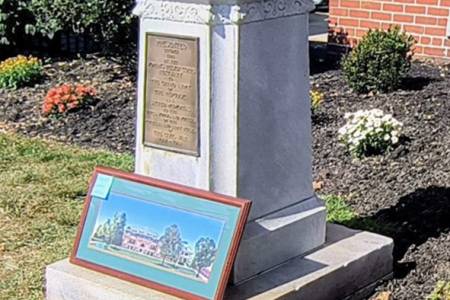 On October 4, 2025 Madison Historical Society of Ohio was able to have their sundial returned after 32 years, when in 1993 it was moved to the lawn of Lake County Courthouse to reduce the chance of vandalism. The sundial was originally placed at Madison Home 100 years ago on Saturday, October 24, 1925 during a conference of the Women's Relief Society. From 1904 to 1962 the state ran this...
On October 4, 2025 Madison Historical Society of Ohio was able to have their sundial returned after 32 years, when in 1993 it was moved to the lawn of Lake County Courthouse to reduce the chance of vandalism. The sundial was originally placed at Madison Home 100 years ago on Saturday, October 24, 1925 during a conference of the Women's Relief Society. From 1904 to 1962 the state ran this...
Elements of Dialing Course - 2025
Monday, 15 September 2025 19:42
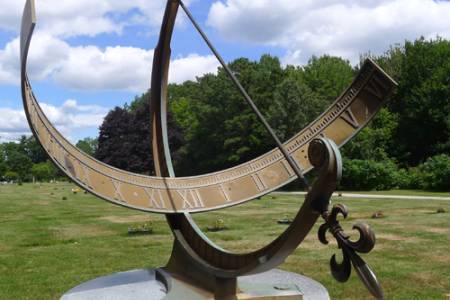 NASS is pleased to announce the upcoming fifth instance of Elements of Dialing, our introductory course about sundials, their history, and the science that makes them work. The free 12-lesson course, intended for those are new to sundialing, runs from 27 October 2025 until 26 April 2026. The course instructor is Robert Kellogg, NASS Vice President and Sundial Registrar. Bob will be...
NASS is pleased to announce the upcoming fifth instance of Elements of Dialing, our introductory course about sundials, their history, and the science that makes them work. The free 12-lesson course, intended for those are new to sundialing, runs from 27 October 2025 until 26 April 2026. The course instructor is Robert Kellogg, NASS Vice President and Sundial Registrar. Bob will be...
Sun Queen of World War II
Thursday, 11 September 2025 23:11
 A Hungarian born American scientist, Mária Telkes (1900-1995), was called "The Sun Queen" and among other honors, was postmousthly inducted into the National Inventors Hall of Fame. She lived to 95 and for most of her life developed solar power in a variety of forms.
Trained as a biophysicist, she worked for Westinghouse Electrical and Manufacturing Company in Pittsburgh, PA, where she...
A Hungarian born American scientist, Mária Telkes (1900-1995), was called "The Sun Queen" and among other honors, was postmousthly inducted into the National Inventors Hall of Fame. She lived to 95 and for most of her life developed solar power in a variety of forms.
Trained as a biophysicist, she worked for Westinghouse Electrical and Manufacturing Company in Pittsburgh, PA, where she...
2025 Conference -Ottawa
Thursday, 28 August 2025 23:25
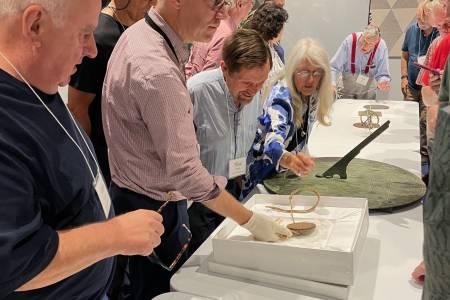 The annual NASS Conference was held 7-10 August, 2025 in Ottawa. As usual, the conference began late Thursday afternoon with an introduction social and a "grab bag give away", taking your chances with tickets to win the bag's prize. Will Grant was the final winner of the Walton Double Planar Polar Sundial, but Paul Ulbrich beat the statistic odds and won this prize three times,...
The annual NASS Conference was held 7-10 August, 2025 in Ottawa. As usual, the conference began late Thursday afternoon with an introduction social and a "grab bag give away", taking your chances with tickets to win the bag's prize. Will Grant was the final winner of the Walton Double Planar Polar Sundial, but Paul Ulbrich beat the statistic odds and won this prize three times,...
Prosciutto di Portici Sundial's Owner
Tuesday, 10 June 2025 18:51
 Prosciutto di Portici (Ham) Sundial
Photo: Getty Images
The Prosciutto di Portici Sundial, more often called the Portici Ham Sundial, dates from the first century somewhere between 8 BCE to 79 CE. This small silvered bronze dial was uncovered on 11 June, 1755 in the ruins of Herculaneum (current day Portici) in the "Villa of the Papyri", buried in...
Prosciutto di Portici (Ham) Sundial
Photo: Getty Images
The Prosciutto di Portici Sundial, more often called the Portici Ham Sundial, dates from the first century somewhere between 8 BCE to 79 CE. This small silvered bronze dial was uncovered on 11 June, 1755 in the ruins of Herculaneum (current day Portici) in the "Villa of the Papyri", buried in...
Hamilton Dial Dedicated
Friday, 06 June 2025 21:01
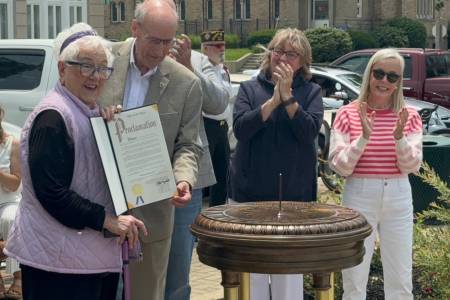 Sundial dedication May 31, 2025. At left is Kathleen Stuckey Fox, with the City Proclamation presented by Mayor Pat Moeller and City Council on-lookers Carla Fiehrer and Susan Vaughn offering congratulations.
On May 31, 2025 at 1pm, the Hamilton, Ohio, sundial (NASS Sundial Registry #1109) was re-dedicated in Monument Park. Originally dedicated in 1941 to the...
Sundial dedication May 31, 2025. At left is Kathleen Stuckey Fox, with the City Proclamation presented by Mayor Pat Moeller and City Council on-lookers Carla Fiehrer and Susan Vaughn offering congratulations.
On May 31, 2025 at 1pm, the Hamilton, Ohio, sundial (NASS Sundial Registry #1109) was re-dedicated in Monument Park. Originally dedicated in 1941 to the...
Frans Maes Received a Royal Decoration
Monday, 24 March 2025 21:33
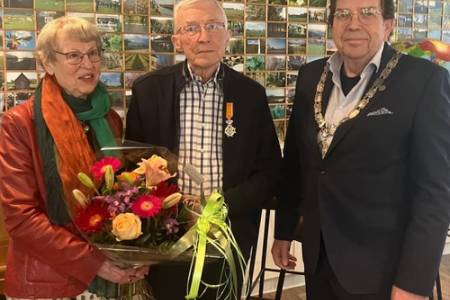 Several years ago Frans decided to write the course on sundials that included self assessment questions to force students not only to read the text, but to internalize the concepts. And a final submittal question "not necessarily a difficult question, but: no answer, no new lesson." Thus Frans Maes began writing lessons and sending them out to students.
NASS has now used his material to create...
Several years ago Frans decided to write the course on sundials that included self assessment questions to force students not only to read the text, but to internalize the concepts. And a final submittal question "not necessarily a difficult question, but: no answer, no new lesson." Thus Frans Maes began writing lessons and sending them out to students.
NASS has now used his material to create...
Pros and Cons of Daylight Savings Time
Monday, 24 March 2025 15:37
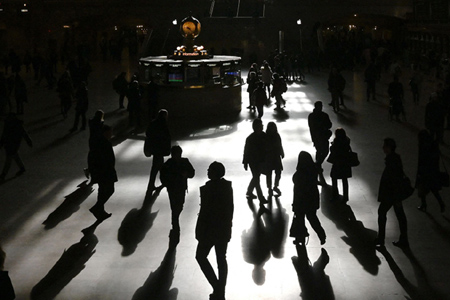 In a 24 March 2025 article from the on-line Science Advisor (American Association for the Advancement of Science) Phie Jacobs summarizes the "great debate" of the yearly shift from standard time to daylight savings time. In January 2025 the US Senate introduced the Sunshine Protection Act to permanently have daylight savings time year round. Certainly 54% of Americans do not like the...
In a 24 March 2025 article from the on-line Science Advisor (American Association for the Advancement of Science) Phie Jacobs summarizes the "great debate" of the yearly shift from standard time to daylight savings time. In January 2025 the US Senate introduced the Sunshine Protection Act to permanently have daylight savings time year round. Certainly 54% of Americans do not like the...
Native American Moon Alignment Ring
Friday, 21 March 2025 19:26
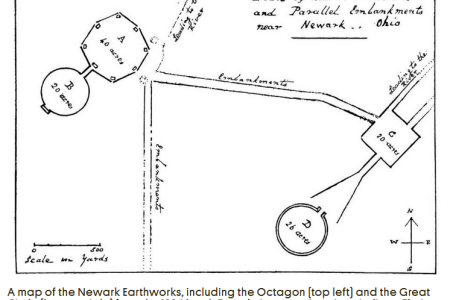 Perhaps the most famous alignment circle in the United States is the Cahokia Woodhenge near St. Louis constructed between 700-1400 CE by Cahokia Indigenous native Americans. But there were an estimated 10,000 other earthen mounds that once were scatter across the mid-west..
In an article from Atlas Obscura (https://www.atlasobscura.com/articles/octagon-earthworks-ohio) by Olivia Young on March...
Perhaps the most famous alignment circle in the United States is the Cahokia Woodhenge near St. Louis constructed between 700-1400 CE by Cahokia Indigenous native Americans. But there were an estimated 10,000 other earthen mounds that once were scatter across the mid-west..
In an article from Atlas Obscura (https://www.atlasobscura.com/articles/octagon-earthworks-ohio) by Olivia Young on March...
Hamilton Dial under Restoration
Friday, 21 March 2025 18:37
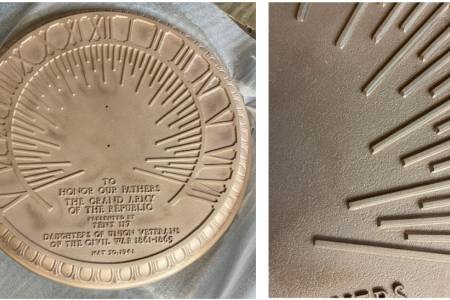 The Hamilton dial is in the restorative care of Jarrett and Celene Hawkins (Hawkins & Hawkins Custom, LLC in Cincinnati Ohio https://www.studio-hawkins.com/) in preparation for the dial's dedication on Saturday, May 31, 2025.
The face of the Hamilton Grand Army of the Republic (GAR) sundial has been cleaned and bead-blasted showing the dial as it was cast 84 years ago. In the process,...
The Hamilton dial is in the restorative care of Jarrett and Celene Hawkins (Hawkins & Hawkins Custom, LLC in Cincinnati Ohio https://www.studio-hawkins.com/) in preparation for the dial's dedication on Saturday, May 31, 2025.
The face of the Hamilton Grand Army of the Republic (GAR) sundial has been cleaned and bead-blasted showing the dial as it was cast 84 years ago. In the process,...
VSSC Space Museum gets Polar Sundial
Tuesday, 17 December 2024 23:47
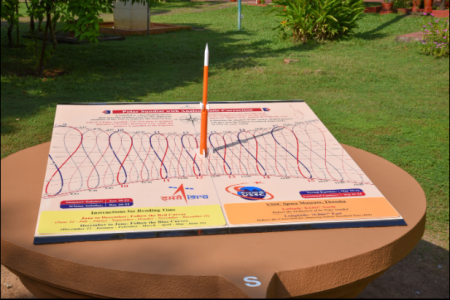 In November 2024, a team consisting of members from SPL, TTDG and CMD of VSSC successfully designed and installed an accurate and fully functional sundial at the Rocket Garden of VSSC Space Museum, Thumba (8.53°N, 76.86°E). Following a space theme, the vertical gnomon is a 3-stage rocket that casts its daily and seasonal shadow on a dial face 1 1/2 meters by 1 meter. The the sundial face...
In November 2024, a team consisting of members from SPL, TTDG and CMD of VSSC successfully designed and installed an accurate and fully functional sundial at the Rocket Garden of VSSC Space Museum, Thumba (8.53°N, 76.86°E). Following a space theme, the vertical gnomon is a 3-stage rocket that casts its daily and seasonal shadow on a dial face 1 1/2 meters by 1 meter. The the sundial face...
Historic Sundials of Andalusia
Saturday, 16 November 2024 00:07
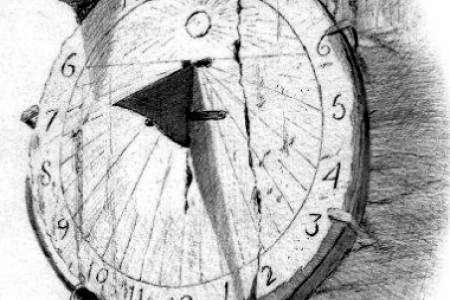 Esteban Martínez Almirón has published a new book Historical Sundials: Forgotten Andalusian Treasures (Relojes de Sol Históricos Tesoros Andaluces Olvidados) In it he reviews over 400 sundials from the Andalucian region of southern Spain Originally to celebrate the 25th year of the website https://relojandalusi.org/
Esteban Martínez Almirón began showing his sundial drawings on the site....
Esteban Martínez Almirón has published a new book Historical Sundials: Forgotten Andalusian Treasures (Relojes de Sol Históricos Tesoros Andaluces Olvidados) In it he reviews over 400 sundials from the Andalucian region of southern Spain Originally to celebrate the 25th year of the website https://relojandalusi.org/
Esteban Martínez Almirón began showing his sundial drawings on the site....
Granite Sundial at Penn State
- Details
- Hits: 14614

On September 22, 2011 Penn State University dedicated a massive granite sundial donated by trustee and alumnus Joel Myers. Designed and sculptured by artist Mark Mennin, it is installed in the university's arboretum. At the dedication Myers said, "We wanted to create something unique...The sundial is to be a destination". Though still lacking a few final touches, such as a bit of polishing, the large granite dial is functional and tells time to the nearest minute.
Heliodome
- Details
- Hits: 17480
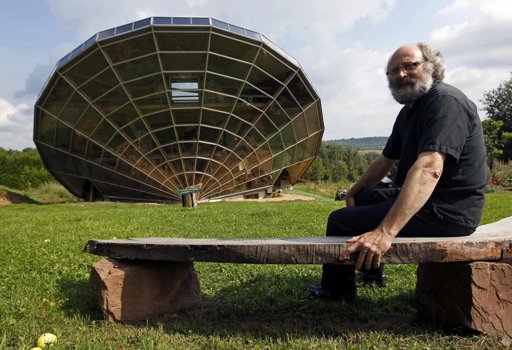
[photo credit: Vincent Kessler]
|
A three dimensional sundial house? You can find it at 10 rue du Diebach, Cosswiller near Strasbourg in the countryside of Alsace in France. Eric Wasser has created the "Heliodome", a tilted circular building aligned with the earth's polar axis that is a far cry from the old Buckminister Fuller "Bucky Domes".
The house has a glassed southern exposure to allow sunlight during the winter, but from the equatorial belt forward the house has a nearly conventional roof providing shade during the summer. As Wasser explains on his website, "The passive solar house is an architectural volume, a Heliodome, determined by the diurnal and annual trajectory of the sun." Read more about the details at http://www.heliodome.com/equipe.html.
Sundial Glass
- Details
- Hits: 13183
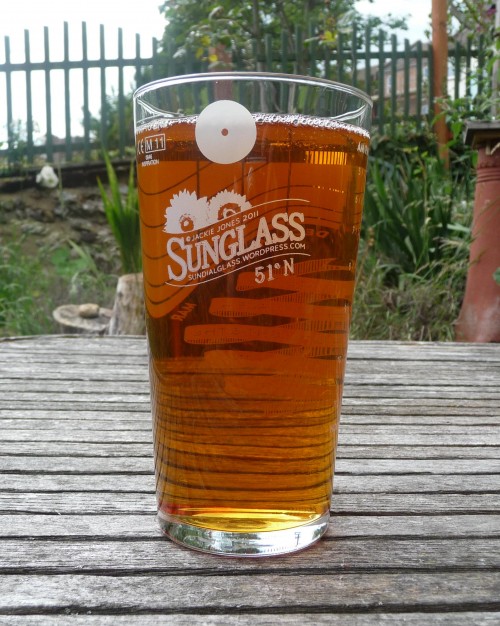
[photo courtesy of
Jackie Jones]
|
All right mate, have a pint of golden sun. You can pick up a sundial beer glass designed by Jackie Jones for 51o North at The Greys Pub in Southover Street Brighton, or if you're out of the country, the dial will work in Banff, Canada, the European cities of Calais, Brussels, and Dresden, and in Kazahstan or other points of equal latitude
The sundial glass motto? “Campaigning for real time”. The sundial glass is a sun altitude type of dial using a frosted ring on one side of the glass to cast a spot of light onto the far side of the glass, calibrated with hour lines for the date of year. Not a bad way to contemplate the time while having a sip. You can get your own sundial glass at http://sundialglass.wordpress.com/
It Looks Like a Sundial - But Is It?
- Details
- Hits: 10499
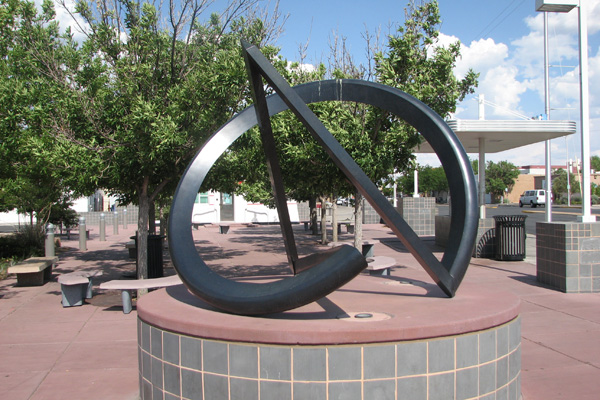
Thanks to Andy Robertson
|
Recent examination of our Sundial Registry revealed dials that no longer exist and have been replaced with something else that might resemble a sundial, but isn't. Consider the brief entry of Dial 56 that may have once existed in Albuquerque, New Mexico on 9 Mimosa Road:
500 Foot Tall Gnomon Project
- Details
- Hits: 12611
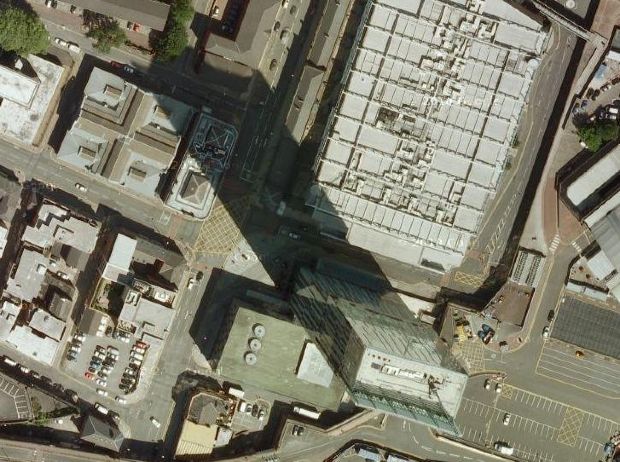 |
While using Google Maps, some artists living in the UK became unusual dialists when it occurred to them that the shadow cast by a skyscraper could be used as the gnomon of a really tall sundial.
The forty-seven story Beetham Tower in Manchester is 554 feet tall and dominates the city's skyline. So it occurred to Annie Harrison, Jude Macpherson and Jacqueline Wylie to use the shadow cast by this structure to chart the progress of the sun as part of an art project.
Oro Valley Sundial
- Details
- Hits: 24429
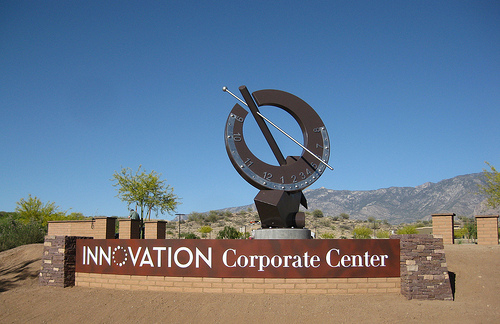 Its not often a sundial is also a monumental piece of sculpture weighing tons, but that is what developer Fred Steiniger installed this May at the Innovation Corporate Center in Oro Valley, Arizona. Long-time NASS member and professional dialist John Carmichael was intimately involved with the 3-year long project, which is still ongoing. Carmichael still has to install a noon-line sundial. Project completion is sometime this year before the planned dedication slated for noon at Autumnal Equinox.
Its not often a sundial is also a monumental piece of sculpture weighing tons, but that is what developer Fred Steiniger installed this May at the Innovation Corporate Center in Oro Valley, Arizona. Long-time NASS member and professional dialist John Carmichael was intimately involved with the 3-year long project, which is still ongoing. Carmichael still has to install a noon-line sundial. Project completion is sometime this year before the planned dedication slated for noon at Autumnal Equinox.
Peninsula College Sundial
- Details
- Hits: 14653
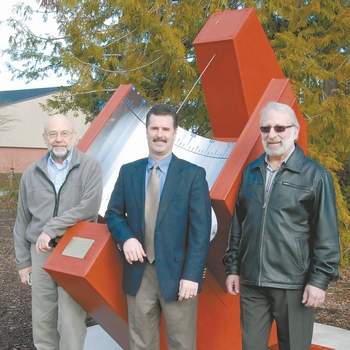
[all photos courtesy of Dennis Sanford,
3Peninsula College
|
Located in Port Angeles, Washington, Peninsula College recently dedicated a sundial measuring eight feet in height. The dial is notable for its unusual design: the basic construction is one of a polar dial, but also includes the sun's analemma so dial viewers can correct for the equation of time.
The dial was designed by the late Ben Davis and donated to the school in his honor by Honey Davis, his mother. Installed on campus near the Science and Technology Building, Dr. Tom Keegan perhaps expressed sentiments the best when he said, “Honey Davis’ very generous gift to Peninsula College is deeply appreciated. It’s fitting that it be placed by our Science and Technology Building so that Ben’s amazing engineering skills serve as an inspiration to our students and encourage them to stop and look and study his sundial."
Bowie Dial Dedicated
- Details
- Hits: 19415
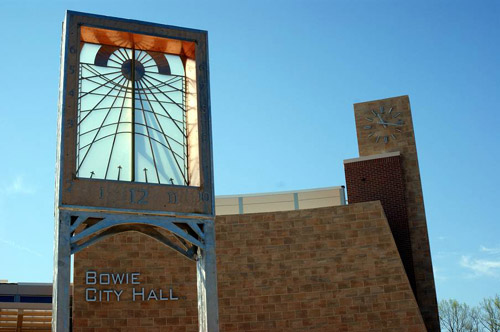 After more than a year of construction, the new Bowie City Hall and the Bowie Portal Dial off Evergreen Parkway and Emerald Avenue in Bowie, Maryland, will be dedicated on the 7th of May, 2011. The City Hall, Police Station along with two works of public art, an interior mobile and the 15-foot steel and bronze sundial will grace the City of Bowie
After more than a year of construction, the new Bowie City Hall and the Bowie Portal Dial off Evergreen Parkway and Emerald Avenue in Bowie, Maryland, will be dedicated on the 7th of May, 2011. The City Hall, Police Station along with two works of public art, an interior mobile and the 15-foot steel and bronze sundial will grace the City of Bowie
Wienhenge Sundial
- Details
- Hits: 11011
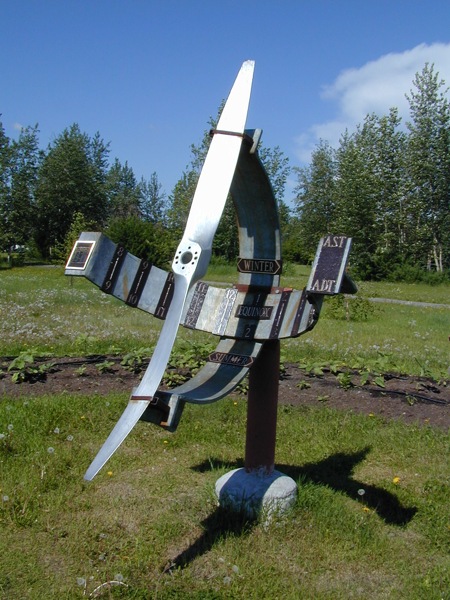
[photo courtesy of Martin Gutoski]
|
A nearly twenty year project to build a sundial near the Arctic Circle in Fairbanks, Alaska was finished this year by Martin Gutoski, a professional surveyor. Gutoski conceived the idea in 1992 when he reviewed a survey for the local library in Fairbanks’ North Star Borough. Originally out of concern for safe-guarding survey corners, he got in contact with a local club whose members saw to the landscaping of the library and other public buildings. One thing lead to another and so began the odyssey that ended just recently.
One interesting aspect that will appeal to anyone who has ever built or contemplated building a sundial is that the dial location is only about one and one-half degrees south of the Arctic Circle. This is an aspect which Gutoski fully explored with models, first a small one and later a full-scale wooden one, before committing the design to its final form, which uses an airplane propeller for the gnomon.
Click on "Read More" below to see more photos of this sundial.
Site Search
Sundial Question?
Current Sun
Civil = Sundial + EoT + dLon
where dLon is (4xNr Degrees W. of Time Zone
Select Sundials by State/Province
Who's Online
We have 875 guests and no members online
